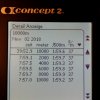Harald Motz
Level 8 Valued Member
high heart rates are no indication for developing "endurance" per se. In LED there there happens blood flow with little restrictions, there is steady continuous power demand with continuous gas exchange, there is steady state homeostasis, relatively little involvement of fast fibers, lots of slow fibers where mitochondria party with carbs, fat and oxygen and because they have so much fun together they are getting more....It seems like LED work offers something unique, though, and I'm wondering why that is.
in my biased thinking A+A alone is better than LED alone, for people who seek either or.A+A+LED is better than A+A alone.
A+A+LED it is.


